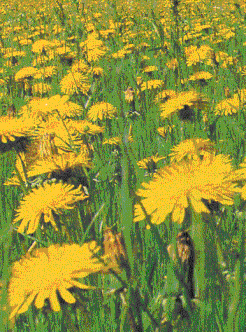Difference between revisions of "Aufgaben:Exercise 2.5Z: Flower Meadow"
From LNTwww
m (Text replacement - "rms value" to "standard deviation") |
|||
| Line 34: | Line 34: | ||
| − | {Determine the | + | {Determine the standard deviation of the random variable $z$. |
|type="{}"} | |type="{}"} | ||
$\sigma_z\ = \ $ { 1.732 3% } | $\sigma_z\ = \ $ { 1.732 3% } | ||
| Line 43: | Line 43: | ||
+ Actually, one would have to use considerably more than ten random numbers (squares) for the moment calculation. | + Actually, one would have to use considerably more than ten random numbers (squares) for the moment calculation. | ||
+ The random variable $z$ is in fact Poisson distributed. | + The random variable $z$ is in fact Poisson distributed. | ||
| − | - The rate $\lambda$ of the Poisson distribution is equal to the | + | - The rate $\lambda$ of the Poisson distribution is equal to the standard deviation $\sigma_z$. |
+ The rate $\lambda$ of the Poisson distribution is equal to the mean $m_z$. | + The rate $\lambda$ of the Poisson distribution is equal to the mean $m_z$. | ||
| Line 71: | Line 71: | ||
*According to Steiner's theorem, the variance is: | *According to Steiner's theorem, the variance is: | ||
:$$\sigma_z^2 =12 -3^2 = 3,$$ | :$$\sigma_z^2 =12 -3^2 = 3,$$ | ||
| − | :and thus the | + | :and thus the standard deviation: |
:$$\underline{\sigma_z \approx 1.732}.$$ | :$$\underline{\sigma_z \approx 1.732}.$$ | ||
'''(3)''' Correct are <u>solutions 1, 2, and 4</u>: | '''(3)''' Correct are <u>solutions 1, 2, and 4</u>: | ||
| − | *Mean and rms agree here. This is indicative of the Poisson distribution with rate $\lambda = 3$ <br>(equal to the mean and equal to the variance, not equal to the | + | *Mean and rms agree here. This is indicative of the Poisson distribution with rate $\lambda = 3$ <br>(equal to the mean and equal to the variance, not equal to the standard deviation). |
*Naturally, it is questionable to make this statement on the basis of only ten values. | *Naturally, it is questionable to make this statement on the basis of only ten values. | ||
*However, in the case of moments, a smaller sample number is less serious than, for example, in the case of probabilities. | *However, in the case of moments, a smaller sample number is less serious than, for example, in the case of probabilities. | ||
Revision as of 12:11, 17 February 2022
A farmer is happy about the splendor of flowers on his land and wants to know how many dandelions are currently blooming on his meadow.
- He knows that the meadow has an area of $5000$ square meters and he also knows from the agricultural school that the number of flowers in a small area is always Poisson distributed.
- He stakes out ten squares, each with an edge length of $\text{25 cm}$, randomly distributed over the entire meadow and counts the flowers in each of these squares:
- $$\rm 3, \ 4, \ 1, \ 5, \ 0, \ 3, \ 2, \ 4, \ 2, \ 6.$$
Consider these numerical values as random results of the discrete random variable $z$.
It is obvious that the sample size $(10)$ is very small but – this much is revealed – the farmer is lucky. First consider how you would proceed to solve this task, and then answer the following questions.
Hints:
- This exercise belongs to the chapter Poisson Distribution.
- Reference is also made to the chapter Moments of a Discrete Random Variable.
Questions
Solution
(1) The linear mean of these ten numbers gives
- $$\underline{m_z = 3}.$$
(2) For the quadratic mean of the random variable $z$ applies accordingly:
- $$m_{\rm 2\it z}=\frac{1}{10}\cdot (0^2+1^2+ 2\cdot 2^2+ 2\cdot 3^2+2\cdot 4^2+ 5^2+6^2)=12.$$
- According to Steiner's theorem, the variance is:
- $$\sigma_z^2 =12 -3^2 = 3,$$
- and thus the standard deviation:
- $$\underline{\sigma_z \approx 1.732}.$$
(3) Correct are solutions 1, 2, and 4:
- Mean and rms agree here. This is indicative of the Poisson distribution with rate $\lambda = 3$
(equal to the mean and equal to the variance, not equal to the standard deviation). - Naturally, it is questionable to make this statement on the basis of only ten values.
- However, in the case of moments, a smaller sample number is less serious than, for example, in the case of probabilities.
(4) In total, there are $80000$ such squares, each with three flowers in the mean.
- This suggests a total of $\underline{B = 240}$ thousand flowers.
(5) According to the Poisson distribution, this probability results in
- $${\rm Pr}(z = 0) = \frac{3^0}{0!} \cdot{\rm e}^{-3}\hspace{0.15cm}\underline{\approx 5\%}.$$
- However, the small sample size $N = 10$ on which this task was based would have indicated probability ${\rm Pr}(z = 0) = { 10\%}$
since only in a single square no single flower was counted.
